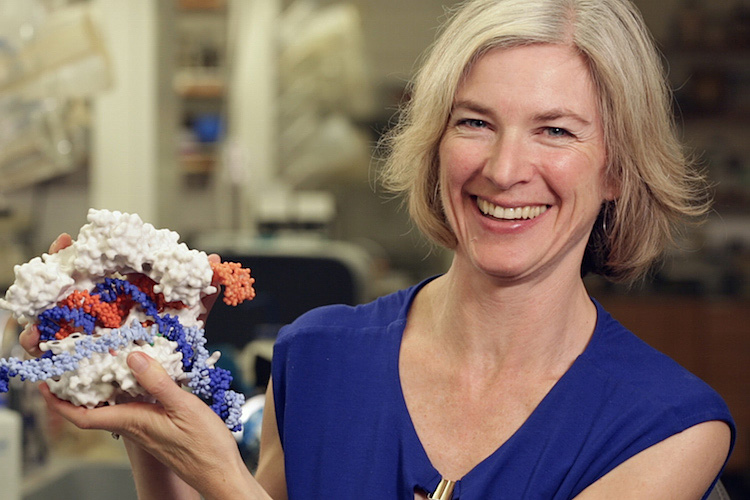The Good, the Bad, and the Unclear: Talking Gene Editing with Jennifer Doudna

Jennifer Doudna holds a 3D-printed model of the enzyme and RNA fragment that make up CRISPR-Cas9. Photo from a video by Roxanne Makasdjian and Stephen McNally/UC Berkeley Media Relations.
SAN FRANCISCO—She wasn’t trying to create a gene-editing tool that would change the world. Jennifer Doudna was just curious—and she really liked RNA.
She hadn’t always loved it, though. Scientists initially thought RNA, DNA’s single-stranded sibling, was a “throwaway molecule,” which sounded to Doudna “like the most boring molecule imaginable.” But when she learned about the many roles of RNA, Doudna made it central to her research at the University of California, Berkeley.
Eventually, studying the molecule’s role in bacterial defense mechanisms led her somewhere unexpected: to CRISPR-Cas9, a groundbreaking tool for precisely editing DNA.
In a talk on 26 October, “Rewriting the Code of Life,” Doudna spoke to hundreds of people at the World Conference of Science Journalists 2017 about CRISPR-Cas9. The technology she co-invented has huge potential. It could lead to drought-resistant crops, mosquitos that can’t spread sickness, or even a cure for genetic diseases. Already scientists across the globe use it to study everything from Neandertals to zebrafish.
But as CRISPR has spread, Doudna and other scientists have been forced to confront some of the thorny ethical concerns raised by this powerful tool.
A molecular machine
CRISPR works through a partnership between short sections of “guide RNA” and an enzyme called Cas-9. Together they make a molecular machine that snoops around a cell’s DNA until it finds a segment matching the guide RNA code. It will then latch on, open up the double helix, and snip both strands.
The cell will notice the break and start damage control, either sewing the two ends back together or patching the tear with a new strand of DNA. Scientists can hijack the repair process and tell the cell to insert a segment that wasn’t there before, thereby editing the DNA.
To date, Doudna says, there's no type of cell in which CRISPR-Cas9 hasn't worked.
This isn’t the first gene-editing tool available, but it has flourished in labs around the world because it is the cheapest and easiest to use. Thousands of studies have been made possible (or at least easier) with CRISPR-Cas9. And to date, Doudna said, there’s no type of cell it hasn’t worked in, from mosquitos to monkeys.
With the tool, one researcher produced tomato plants with branches that could hold two to three times more fruit. Another created fluorescent frogs. Yet another proposed leaner pigs to make healthier “CRISPR bacon.”
The Hitler scenario
For much of her career, Doudna didn’t think she needed to take part in the ethical discussion about her research. But after watching the rapid spread of CRISPR-Cas9, she began to realize she had a duty as a scientist to enter the conversation. Then, a nightmare convinced her: She dreamed that a friend introduced her to a man interested in CRISPR-Cas9. That man was Adolf Hitler.
“It was the shock of realizing: ‘What happens if a powerful technology gets into the wrong hands?’” Doudna said. With the ability to edit the genome of any species, the possibilities are endless—in ways that can both help and harm our world. While CRISPR could help scientists cure diseases, for example, it could also be harnessed to create deadlier viruses.
For Doudna, three topics demand major ethical conversations about CRISPR-Cas9: crop modification, human embryo editing, and gene drives, where a new genetic trait is “driven” through a population rapidly. Gene drives could be used to make mosquitos unable to transmit disease, for instance. It is controversial because it could affect a whole species irreversibly.
We must discuss how scientists should use these techniques—if at all—and how they can be regulated internationally, Doudna said.
Possibilities and pitfalls
To spark conversations about CRISPR-Cas9, Doudna has spoken around the world, written a book, and founded the Innovative Genomics Institute, a partnership between UC Berkeley and UC San Francisco. She wants scientists, politicians, and the public to talk about how this technology should be used and regulated.
“CRISPR-Cas9 has revolutionized genetics, but it has also sparked deep questions about the possibilities and pitfalls surrounding gene editing,” agreed journalist Alan Boyle, session moderator and president of the Council for the Advancement of Science Writing.
For now, Doudna disagrees with using CRISPR-Cas9 clinically in human embryos, because we don’t yet understand the implications. Because of the complexity of the human genome, we are farther away from choosing our children’s eye color and IQ than some have made it seem, she says.
Still, many scientists are pushing to use CRISPR-Cas9 in humans, even though those approaches are a long way off from clinical trials. But especially for conditions caused by well-studied genetic mutations, such as sickle-cell anemia, Doudna said, “We can’t help but be excited about opportunities to use gene editing to treat disease.”
—
Kelsey Harper, a senior at Johns Hopkins University, will graduate in May with her bachelor’s degree in chemistry. She is pursuing science journalism and has written for the JHU Newsletter and worked as a science writing intern at Brookhaven National Laboratory.
